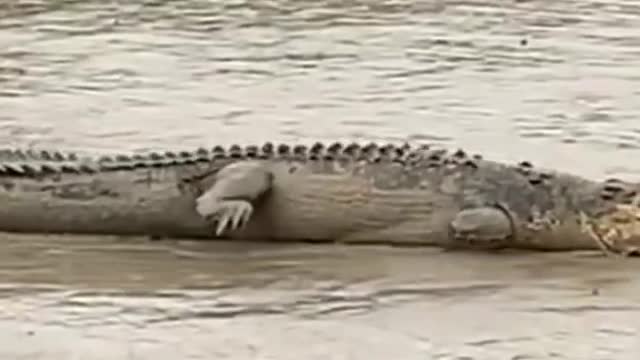Premium Only Content

A big crocodile.
Crocodiles (family Crocodylidae) or true crocodiles are large semiaquatic reptiles that live throughout the tropics in Africa, Asia, the Americas and Australia. The term crocodile is sometimes used even more loosely to include all extant members of the order Crocodilia, which includes the alligators and caimans (family Alligatoridae), the gharial and false gharial (family Gavialidae) among other extinct taxa.
Crocodiles
Temporal range: Eocene–Holocene, 46–0 Ma
PreꞒ
Ꞓ
O
S
D
C
P
T
J
K
Pg
N
Nile crocodile (Crocodylus niloticus)Saltwater crocodile (Crocodylus porosus)Scientific classificationKingdom:AnimaliaPhylum:ChordataClass:ReptiliaOrder:CrocodiliaSuperfamily:CrocodyloideaFamily:Crocodylidae
Cuvier, 1807Type genusCrocodylus
Laurenti, 1768
Subfamilies
Crocodylinae
Osteolaeminae
Although they appear similar, crocodiles, alligators and the gharial belong to separate biological families. The gharial, with its narrow snout, is easier to distinguish, while morphological differences are more difficult to spot in crocodiles and alligators. The most obvious external differences are visible in the head, with crocodiles having narrower and longer heads, with a more V-shaped than a U-shaped snout compared to alligators and caimans. Another obvious trait is that the upper and lower jaws of the crocodiles are the same width, and the teeth in the lower jaw fall along the edge or outside the upper jaw when the mouth is closed; therefore, all teeth are visible, unlike an alligator, which possesses in the upper jaw small depressions into which the lower teeth fit. Also, when the crocodile's mouth is closed, the large fourth tooth in the lower jaw fits into a constriction in the upper jaw. For hard-to-distinguish specimens, the protruding tooth is the most reliable feature to define the species' family.[1] Crocodiles have more webbing on the toes of the hind feet and can better tolerate saltwater due to specialized salt glands for filtering out salt, which are present, but non-functioning, in alligators. Another trait that separates crocodiles from other crocodilians is their much higher levels of aggression.[2]
Crocodile size, morphology, behaviour and ecology differ somewhat among species. However, they have many similarities in these areas as well. All crocodiles are semiaquatic and tend to congregate in freshwater habitats such as rivers, lakes, wetlands and sometimes in brackish water and saltwater. They are carnivorous animals, feeding mostly on vertebrates such as fish, reptiles, birds and mammals, and sometimes on invertebrates such as molluscs and crustaceans, depending on species and age. All crocodiles are tropical species that, unlike alligators, are very sensitive to cold. They separated from other crocodilians during the Eocene epoch, about 55 million years ago.[3] Many species are at the risk of extinction, some being classified as critically endangered.
-
 1:27
1:27
Animals Planet
2 years ago10 minutes after birth kittens meow loudly.
3391 -
 2:03:07
2:03:07
vivafrei
12 hours agoEp. 283: Charlie Kirk Memorial and other Stuff in the Law World
235K218 -
 9:13:12
9:13:12
The Charlie Kirk Show
23 hours agoLIVE NOW: Building A Legacy, Remembering Charlie Kirk
2.19M976 -
 1:55:20
1:55:20
The White House
15 hours agoPresident Trump Participates in the Memorial Service for Charlie Kirk
120K97 -
 1:02:41
1:02:41
Sarah Westall
14 hours agoDomestic Terror Operation: Death Threats, Smear Campaigns, Gang Stalking w/ Journalist Sarah Fields
76.1K11 -
 1:51:40
1:51:40
Nerdrotic
14 hours ago $26.25 earnedGobekli Tepe Discovery and "Reconstruction" | Forbidden Frontier #118
113K14 -
 29:07
29:07
Tactical Advisor
14 hours agoATF Changes Ruling on SBR & Tacpack unboxing | Vault Room Live Stream 039
112K21 -
 2:00
2:00
From Zero → Viral with AI
20 hours ago $6.84 earnedAre You Being Left Behind? Why AI Marketing is No Longer Optional
62.1K11 -
 9:10
9:10
BlackDiamondGunsandGear
18 hours agoI Finally Got it! / Rough Country Build Ep.1
42.2K12 -
 9:44
9:44
Millionaire Mentor
3 days agoCharlie Kirk Brings Woke Student To STUTTERING Over White Privilege Lies
42.7K17